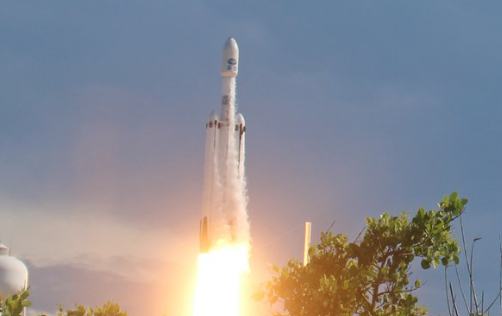Around 5:26 p.m., NASA successfully launched the fourth and last advanced weather satellite for the National Oceanic and Atmospheric Administration.EDT on Tuesday. The GOES-U (Geostationary Operational Environmental Satellite) aims to enhance weather monitoring and environmental condition tracking across much of the Western Hemisphere.
The satellite was launched aboard a SpaceX Falcon Heavy rocket from Launch Complex 39A at NASA’s Kennedy Space Center in Florida. By 10:18 p.m., mission managers confirmed that the spacecraft’s solar arrays had successfully deployed, and it was operating on its own power.
SpaceX’s Falcon Heavy launched the final GOES-U weather satellite for NASA and NOAA from Kennedy Space Center. This satellite will enhance weather monitoring across the Western Hemisphere. The rocket’s twin boosters made a precision landing at Cape Canaveral. #SpaceX #NASA pic.twitter.com/9kTmZTAKrL
— CGTN Europe (@CGTNEurope) June 26, 2024
“Satellites like GOES-U play a crucial role in monitoring real-time weather as communities worldwide experience extreme weather conditions,” said NASA Administrator Bill Nelson.”NASA and NOAA have worked together for many years to provide vital data for severe storm readiness, fire detection, and other purposes. This advanced fleet of satellites bolsters our resilience to climate change and protects against weather hazards on Earth and in space.”
Beyond its primary function in terrestrial weather prediction, the GOES constellation also aids in forecasting space weather near Earth, which can disrupt satellite electronics, GPS, and radio communications. The GOES-U satellite includes the new Compact Coronagraph-1, a space weather instrument that blocks the Sun’s bright light, allowing scientists to observe the fainter solar atmosphere.
“GOES data has numerous applications that directly affect our daily lives,” said Nicky Fox, associate administrator for the Science Mission Directorate at NASA Headquarters in Washington. “GOES-U will enhance the global data record, enabling NASA and NOAA to track climate changes and provide critical information before severe weather and natural disasters occur. We look forward to collaborating with NOAA on the next generation of Earth-observing satellites.”
Oh, here it GOES, here it GOES again.
Relive the incredible journey that brought @NOAASatellites‘ GOES-U successfully into orbit. It will provide advanced imagery, real-time mapping of lightning activity and persistent monitoring of solar activity and space weather. pic.twitter.com/MekQO44ka6
— Lockheed Martin Space (@LMSpace) June 26, 2024
Once GOES-U reaches its geostationary orbit, approximately 22,200 miles above Earth, it will be renamed GOES-19. After a successful orbital checkout of its instruments and systems, GOES-19 will commence operations, monitoring weather over North America, including the contiguous United States and Mexico, as well as Central and South America, the Caribbean, and the Atlantic Ocean up to the west coast of Africa.
“The data provided by GOES-U is vital for protecting the safety of people in the Western Hemisphere,” said John Gagosian, director of NASA’s Joint Agency Satellite Division. “With this successful launch, forecasters will have a valuable resource to better inform and educate the public.”
NASA’s Goddard Space Flight Center in Greenbelt, Maryland, managed the acquisition of the GOES-R series spacecraft and instruments and built the magnetometer for GOES-U and its predecessor, GOES-T. NASA’s Launch Services Program, based at Kennedy, provided launch management for the mission.
A #SpaceX Falcon Heavy rocket launched the fourth and final satellite of #NASA and NOAA’s next-generation geostationary weather satellites from Kennedy Space Center. The GOES-U satellite is designed to enhance weather monitoring capabilities across the Western Hemisphere. pic.twitter.com/ulkF671XqV
— William John (@Johnwilliam_123) June 26, 2024
The GOES-R Series Program is managed by NOAA through an integrated NOAA-NASA office that oversees the ground system, satellite operations, and data distribution to users worldwide. Lockheed Martin is responsible for designing, building, and testing the GOES-R series satellites, while L3Harris Technologies provides the main instrument payload, the Advanced Baseline Imager, and the ground system, including the data reception antenna system.
Key Points:
i. NASA successfully launched the GOES-U weather satellite, the fourth and final satellite in an advanced series for NOAA, on a SpaceX Falcon Heavy rocket.
ii. The satellite aims to provide continuous weather and environmental condition monitoring across the Western Hemisphere, enhancing preparedness for extreme weather.
iii. GOES-U includes the new Compact Coronagraph-1 instrument to observe the solar atmosphere and help predict space weather that can affect satellite electronics, GPS, and radio communications.
iv. Once in geostationary orbit, GOES-U will be renamed GOES-19 and will monitor weather over North America, Central and South America, the Caribbean, and the Atlantic Ocean.
v. The GOES-R Series Program, managed by NOAA with NASA’s support, involves collaboration with Lockheed Martin and L3Harris Technologies for satellite design, construction, and data reception.
Al Santana – Reprinted with permission of Whatfinger News



